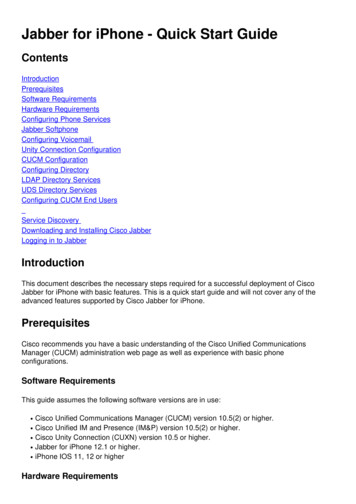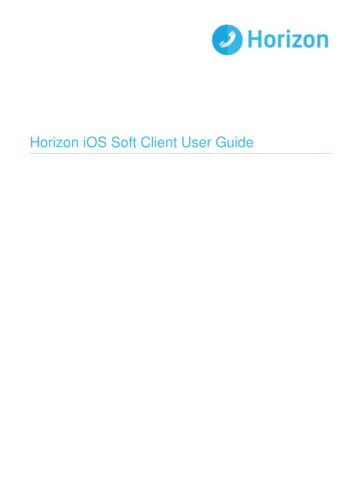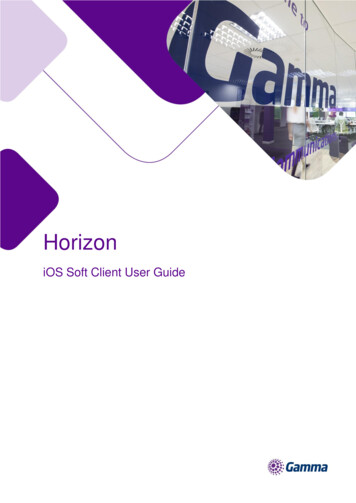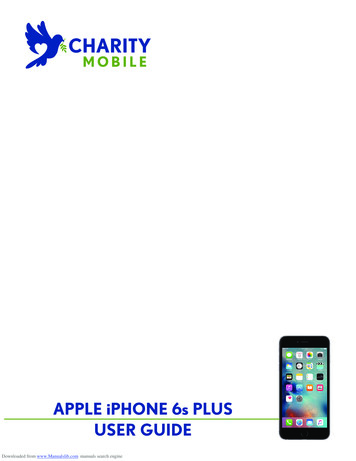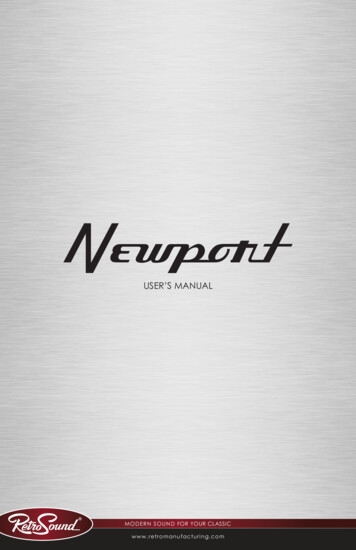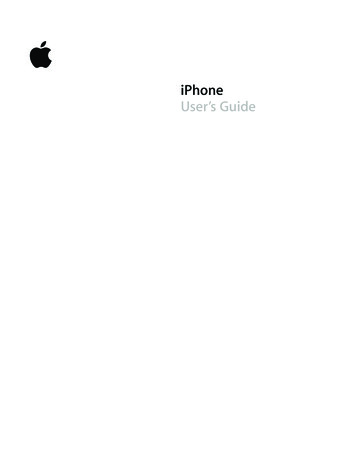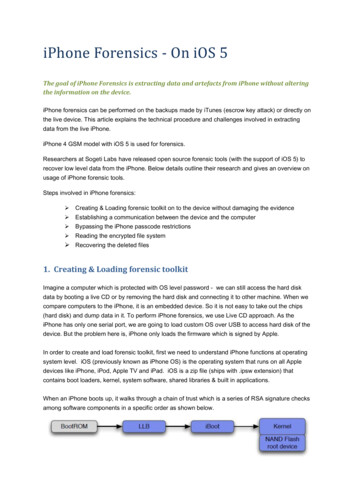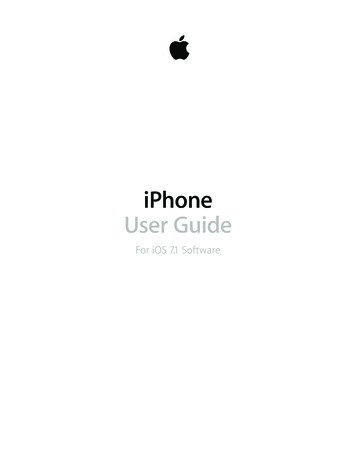
Transcription
iPhoneUser GuideFor iOS 7.1 Software
Contents889101012Chapter 1: iPhone at a Glance141414151516161617171819191920Chapter 2: Getting er 3: BasicsiPhone overviewAccessoriesMulti-Touch screenButtonsStatus iconsInstall the SIM cardSet up and activate iPhoneConnect iPhone to your computerConnect to Wi-FiConnect to the InternetSet up mail and other accountsApple IDManage content on your iOS devicesiCloudSync with iTunesDate and timeInternational settingsYour iPhone nameView this user guide on iPhoneUse appsCustomize iPhoneType textDictateVoice ControlSearchControl CenterAlerts and Notification CenterSounds and silenceDo Not DisturbAirDrop, iCloud, and other ways to shareTransfer filesPersonal HotspotAirPlayAirPrintUse an Apple headsetBluetooth devicesRestrictions2
36373940PrivacySecurityCharge and monitor the batteryTravel with iPhone4141424243Chapter 4: Siri4444474848484849Chapter 5: Phone50505151515253535454Chapter 6: Mail5555555656575758585959Chapter 7: Safari6060616163636364Chapter 8: MusicMake requestsTell Siri about yourselfMake correctionsSiri settingsPhone callsVisual voicemailContactsCall forwarding, call waiting, and caller IDRingtones and vibrationsInternational callsPhone settingsWrite messagesGet a sneak peekFinish a message laterSee important messagesAttachmentsWork with multiple messagesSee and save addressesPrint messagesMail settingsSafari at a glanceSearch the webBrowse the webKeep bookmarksShare what you discoverFill in formsAvoid clutter with ReaderSave a reading list for laterPrivacy and securitySafari settingsiTunes RadioGet musicBrowse and playAlbum WallAudiobooksPlaylistsGenius—made for youContents3
64656566Siri and Voice ControliTunes MatchHome SharingMusic settings676767686969Chapter 9: Messages707071717272Chapter 10: Calendar737374747576777777Chapter 11: Photos787879808081Chapter 12: Camera82Chapter 13: Weather848485Chapter 14: Clock868687878888Chapter 15: Maps898990Chapter 16: VideosSMS, MMS, and iMessagesSend and receive messagesManage conversationsShare photos, videos, and moreMessages settingsCalendar at a glanceInvitationsUse multiple calendarsShare iCloud calendarsCalendar settingsView photos and videosOrganize your photos and videosiCloud Photo SharingMy Photo StreamShare photos and videosEdit photos and trim videosPrint photosPhotos settingsCamera at a glanceTake photos and videosHDRView, share, and printCamera settingsClock at a glanceAlarms and timersFind placesGet more infoGet directions3D and FlyoverMaps settingsVideos at a glanceAdd videos to your libraryContents4
9091Control playbackVideos settings929293Chapter 17: Notes94959595Chapter 18: Reminders96Chapter 19: Stocks98989999Chapter 20: Game CenterNotes at a glanceUse notes in multiple accountsScheduled remindersLocation remindersReminders settingsGame Center at a glancePlay games with friendsGame Center settings100 Chapter 21: Newsstand100 Newsstand at a glance101101101102102Chapter 22: iTunes Store103103104104105Chapter 23: App StoreiTunes Store at a glanceBrowse or searchPurchase, rent, or redeemiTunes Store settingsApp Store at a glanceFind appsPurchase, redeem, and downloadApp Store settings106 Chapter 24: Passbook106 Passbook at a glance106 Passbook on the go107 Passbook settings108 Chapter 25: Compass108 Compass at a glance109 On the level110110110111111Chapter 26: Voice Memos112112113Chapter 27: FaceTimeVoice Memos at a glanceRecordListenMove recordings to your computerFaceTime at a glanceMake and answer callsContents5
113Manage calls114114115115116Chapter 28: Contacts117Chapter 29: Calculator118118118119120120Chapter 30: iBooks121121121122122Chapter 31: Nike iPod123123124124125125Chapter 32: 141141141141141141142Appendix A: AccessibilityContacts at a glanceUse Contacts with PhoneAdd contactsContacts settingsGet iBooksRead a bookOrganize booksRead PDFsiBooks settingsAt a glanceLink and calibrate your sensorWork outNike iPod SettingsPodcasts at a glanceGet podcastsControl playbackOrganize your podcastsPodcasts settingsAccessibility featuresAccessibility ShortcutVoiceOverSiriZoomInvert ColorsSpeak SelectionSpeak Auto-textLarge, bold, and high-contrast textReduce onscreen motionOn/off switch labelsHearing aidsSubtitles and closed captionsLED Flash for AlertsMono audio and balanceCall audio routingAssignable ringtones and vibrationsPhone noise cancellationGuided AccessSwitch ControlContents6
145146146146146146146AssistiveTouchTTY supportVisual voicemailWidescreen keyboardsLarge phone keypadVoice ControlAccessibility in OS X147 Appendix B: International Keyboards147 Use international keyboards148 Special input methods149 Appendix C: iPhone in Business149 Mail, Contacts, and Calendar149 Network access149 59160161Appendix D: Safety, Handling, & SupportImportant safety informationImportant handling informationiPhone Support siteRestart or reset iPhoneReset iPhone settingsGet information about your iPhoneUsage informationDisabled iPhoneBack up iPhoneUpdate and restore iPhone softwareCellular settingsSell or give away iPhone?Learn more, service, and supportFCC compliance statementCanadian regulatory statementDisposal and recycling informationApple and the environmentContents7
1iPhone at a GlanceiPhone overviewThis guide describes the features of iOS 7.1, and of iPhone 4, iPhone 4s, iPhone 5, iPhone 5c, andiPhone 5s.iPhone ophoneStatus barRing/SilentswitchVolumebuttonsApp iconsLED flashiSightcameraRearmicrophoneSIM cardtrayMulti-TouchdisplayHome button/Touch IDsensorBottommicrophoneLightningconnectorHeadset jackSpeakeriPhone tswitchVolumebuttonsSleep/WakebuttonLED flashStatus bariSightcameraRearmicrophoneApp iconsSIM cardtrayMulti-TouchdisplayHome buttonBottommicrophoneLightningconnectorHeadset jackSpeaker8
Your iPhone features and apps may vary depending on the model of iPhone you have, and onyour location, language, and carrier. To find out which features are supported in your area, seewww.apple.com/ios/feature-availability.Note: Apps that send or receive data over a cellular network may incur additional fees. Contactyour carrier for information about your iPhone service plan and fees.AccessoriesThe following accessories are included with iPhone:Apple headset. Use the Apple EarPods with Remote and Mic (iPhone 5 or later) or theApple Earphones with Remote and Mic (iPhone 4s or earlier) to listen to music and videos,and make phone calls. See Use an Apple headset on page 35.Connecting cable. Using the Lightning to USB Cable (iPhone 5 or later) or the 30-pin toUSB Cable (iPhone 4s or earlier), connect iPhone to your computer to sync and charge.Apple USB power adapter. Use with the Lightning to USB Cable or the 30-pin to USB Cable tocharge the iPhone battery.SIM eject tool. Use to eject the SIM card tray. (Not included in all areas.)Chapter 1 iPhone at a Glance9
Multi-Touch screenA few simple gestures—tap, drag, swipe, and pinch/stretch—are all you need to use iPhone andits apps.ButtonsMost of the buttons you use with iPhone are virtual ones on the touchscreen. A few physicalbuttons control basic functions, such as turning iPhone on or adjusting the volume.Sleep/Wake buttonWhen you’re not using iPhone, press the Sleep/Wake button to lock iPhone. Locking iPhone putsthe display to sleep, saves the battery, and prevents anything from happening if you touch thescreen. You can still get phone calls, FaceTime calls, text messages, alarms, and notifications. Youcan also listen to music and adjust the volume.Sleep/WakebuttoniPhone locks automatically if you don’t touch the screen for a minute or so. To adjust the timing,go to Settings General Auto-Lock.Turn iPhone on. Press and hold the Sleep/Wake button until the Apple logo appears.Unlock iPhone. Press either the Sleep/Wake or Home button, then drag the slider.Turn iPhone off. Press and hold the Sleep/Wake button until the slider appears, then dragthe slider.For additional security, you can require a passcode to unlock iPhone. Go to Settings Touch ID& Passcode (iPhone 5s) or Settings Passcode (other models). See Use a passcode with dataprotection on page 37.Chapter 1 iPhone at a Glance10
Home buttonThe Home button takes you to the Home screen, and provides other convenient shortcuts.See apps you’ve opened. Double-click the Home button. See Start at home on page 21.Use Siri (iPhone 4s or later) or Voice Control. Press and hold the Home button. See VoiceControl on page 29 and Chapter 4, Siri, on page 41.On iPhone 5s, you can use the sensor in the Home button to read your fingerprint, instead ofusing your passcode or Apple ID password. See Touch ID sensor on page 38.You can also use the Home button to turn accessibility features on or off. See AccessibilityShortcut on page 127.Volume controlsWhen you’re on the phone or listening to songs, movies, or other media, the buttons on the sideof iPhone adjust the audio volume. Otherwise, the buttons control the volume for the ringer,alerts, and other sound effects.WARNING: For important information about avoiding hearing loss, see Important safetyinformation on page 151.VolumeupVolumedownLock the ringer and alert volumes. Go to Settings Sounds and turn off “Change with Buttons.”To limit the volume for music and videos, go to Settings Music Volume Limit.Note: In some European Union (EU) countries, iPhone may warn that you’re setting the volumeabove the EU recommended level for hearing safety. To increase the volume beyond this level,you may need to briefly release the volume control. To limit the maximum headset volumeto this level, go to Settings Music Volume Limit and turn on EU Volume Limit. To preventchanges to the volume limit, go to Settings General Restrictions.You can also use either volume button to take a picture or record a video. See Take photos andvideos on page 79.Chapter 1 iPhone at a Glance11
Ring/Silent switchFlip the Ring/Silent switch to put iPhone in ring modeor silent mode.RingSilentIn ring mode, iPhone plays all sounds. In silent mode, iPhone doesn’t ring or play alerts and othersound effects.Important: Clock alarms, audio apps such as Music, and many games play sounds through thebuilt-in speaker, even when iPhone is in silent mode. In some areas, the sound effects for Cameraand Voice Memos are played, even if the Ring/Silent switch is set to silent.For information about changing sound and vibration settings, see Sounds and silence onpage 32.Use Do Not Disturb. You can also silence calls, alerts, and notifications using Do Not Disturb.Swipe up from the bottom edge of the screen to open Control Center, then tap . See Do NotDisturb on page 32.Status iconsThe icons in the status bar at the top of the screen give information about iPhone:Status iconWhat it meansCell signalYou’re in range of the cellular network and can make and receivecalls. If there’s no signal, “No service” appears.Airplane modeAirplane mode is on—you can’t make phone calls, and otherwireless functions may be disabled. See Travel with iPhone onpage 40.LTEYour carrier’s LTE network is available, and iPhone can connect tothe Internet over that network. (iPhone 5 or later. Not available in allareas.) See Cellular settings on page 157.UMTSYour carrier’s 4G UMTS (GSM) or LTE network (depending on carrier)is available, and iPhone can connect to the Internet over thatnetwork. (iPhone 4s or later. Not available in all areas.) See Cellularsettings on page 157.UMTS/EV-DOYour carrier’s 3G UMTS (GSM) or EV-DO (CDMA) network is available,and iPhone can connect to the Internet over that network. SeeCellular settings on page 157.EDGEYour carrier’s EDGE (GSM) network is available, and iPhone canconnect to the Internet over that network. See Cellular settings onpage 157.GPRS/1xRTTYour carrier’s GPRS (GSM) or 1xRTT (CDMA) network is available, andiPhone can connect to the Internet over that network. See Cellularsettings on page 157.Wi-FiiPhone is connected to the Internet over a Wi-Fi network. SeeConnect to Wi-Fi on page 15.Chapter 1 iPhone at a Glance12
Status iconWhat it meansDo Not Disturb“Do Not Disturb” is turned on. See Do Not Disturb on page 32.Personal HotspotiPhone is providing a Personal Hotspot for another device. SeePersonal Hotspot on page 33.SyncingiPhone is syncing with iTunes.Network activityShows that there’s network activity. Some third-party apps may alsouse it to show an active process.Call ForwardingCall Forwarding is set up. See Call forwarding, call waiting, and callerID on page 48.VPNYou’re connected to a network using VPN. See Network access onpage 149.TTYiPhone is set to work with a TTY machine. See TTY support onpage 146.Portrait orientationlockThe iPhone screen is locked in portrait orientation. See Change thescreen orientation on page 23.AlarmAn alarm is set. See Alarms and timers on page 85.Location ServicesAn item is using Location Services. See Privacy on page 36.Bluetooth Blue or white icon: Bluetooth is on and paired with a device.Gray icon: Bluetooth is on. If iPhone is paired with a device, thedevice may be out of range or turned off.No icon: Bluetooth is turned off.See Bluetooth devices on page 35.Bluetooth batteryShows the battery level of a paired Bluetooth device.BatteryShows the iPhone battery level or charging status. See Charge andmonitor the battery on page 39.Chapter 1 iPhone at a Glance13
Getting Started·2WARNING: To avoid injury, read Important safety information on page 151 before using iPhone.Install the SIM cardIf you were given a SIM card to install, install it before setting up iPhone.Important: A Micro-SIM card (iPhone 4 and iPhone 4s) or a Nano-SIM card (iPhone 5 or later) isrequired in order to use cellular services when connecting to GSM networks and some CDMAnetworks. An iPhone 4s or later that’s been activated on a CDMA wireless network may also usea SIM card for connecting to a GSM network, primarily for international roaming. Your iPhone issubject to your wireless service provider’s policies, which may include restrictions on switchingservice providers and roaming, even after conclusion of any required minimum service contract.Contact your wireless service provider for more details. Availability of cellular capabilitiesdepends on the wireless network.SIM cardtrayPaper clipor SIMeject toolSIM cardSet up and activate iPhoneActivation can be done over a Wi-Fi network or, with iPhone 4s or later, over your carrier’s cellularnetwork (not available in all areas). If neither option is available, you need to connect iPhone toyour computer and use iTunes to activate iPhone (see the following section).Set up and activate iPhone. Turn on iPhone and follow the Setup Assistant.The Setup Assistant steps you through the process, including: Connecting to a Wi-Fi network Signing in with or creating a free Apple ID (needed for many features, including iCloud,FaceTime, the App Store, the iTunes Store, and more) Entering a passcode Setting up iCloud and iCloud Keychain Turning on recommended features such as Location Services and Find My iPhone Activating iPhone with your carrier14
You can also restore from an iCloud or iTunes backup during setup.Note: If you turn on Find My iPhone during setup, Activation Lock will be turned on in order tohelp deter theft. See Find My iPhone on page 39.Some carriers let you unlock iPhone for use with their network. To see if your carrier offers thisoption, see support.apple.com/kb/HT1937. Contact your carrier for authorization and setupinformation. You need to connect iPhone to iTunes to complete the process. Additional fees mayapply. For more information, see support.apple.com/kb/HT5014.Connect iPhone to your computerYou may need to connect iPhone to your computer in order to complete activation. ConnectingiPhone to your computer also lets you sync photos and other content to iPhone from yourcomputer, using iTunes. See Sync with iTunes on page 18.To use iPhone with your computer, you need: An Internet connection for your computer (broadband is recommended) A Mac or a PC with a USB 2.0 or 3.0 port, and one of the following operating systems: OS X version 10.6.8 or later Windows 8, Windows 7, Windows Vista, or Windows XP Home or Professional with ServicePack 3 or laterConnect iPhone to your computer. Use the Lightning to USB Cable (iPhone 5 or later) or 30-pinto USB Cable (iPhone 4s or earlier) provided with iPhone. You’ll be asked on each device to verify“trust” of the other device.Connect to Wi-FiIfappears at the top of the screen, you’re connected to a Wi-Fi network. iPhone reconnectsanytime you return to the same location.Configure Wi-Fi. Go to Settings Wi-Fi. Choose a network: Tap one of the listed networks and enter the password, if asked.Ask to join networks: Turn on “Ask to Join Networks” to be prompted when a Wi-Fi networkis available. Otherwise, you must manually join a network when a previously used networkisn’t available.next to a network you’ve joined before. Then tap “Forget this Network.” Forget a network: Tap Join a closed Wi-Fi network: Tap Other, then enter the name of the closed network. You mustalready know the network name, security type, and password (if required). Adjust the settings for a Wi-Fi network: Tapnext to a network. You can set an HTTP proxy,define static network settings, turn on BootP, or renew the settings provided by a DHCP server.Chapter 2 Getting Started15
Set up your own Wi-Fi network. If you have an unconfigured AirPort base station turned onand within range, you can use iPhone to set it up. Go to Settings Wi-Fi and look for “Set up anAirPort base station.” Tap your base station and the Setup Assistant will do the rest.Manage an AirPort network. If iPhone is connected to an AirPort base station, go to Settings Wi-Fi, tapnext to the network name, then tap Manage this Network. If you haven’t yetdownloaded AirPort Utility, tap OK to open the App Store and download it.Connect to the InternetiPhone connects to the Internet whenever necessary, using a Wi-Fi connection (if available) oryour carrier’s cellular network. For information about connecting to a Wi-Fi network, see Connectto Wi-Fi, above.When an app needs to use the Internet, iPhone does the following, in order: Connects over the most recently used available Wi-Fi network Shows a list of Wi-Fi networks in range, and connects using the one you choose Connects over the cellular data network, if availableNote: If a Wi-Fi connection to the Internet isn’t available, apps and services may transfer dataover your carrier’s cellular network, which may result in additional fees. Contact your carrierfor information about your cellular data plan rates. To manage cellular data usage, see Cellularsettings on page 157.Set up mail and other accountsiPhone works with iCloud, Microsoft Exchange, and many of the most popular Internet-basedmail, contacts, and calendar service providers.You can set up a free iCloud account when you first set up iPhone, or later in Settings. SeeiCloud on page 17.Set up an account. Go to Settings Mail, Contacts, Calendars Add Account. If you’re setting upan iCloud account, you can also do that in Settings iCloud.You can add contacts using an LDAP or CardDAV account, if your company or organizationsupports it. See Add contacts on page 115.You can add calendars using a CalDAV calendar account, and you can subscribe to iCalendar (.ics)calendars or import them from Mail. See Use multiple calendars on page 71.Apple IDAn Apple ID is the login you use for just about everything you do with Apple, including usingiCloud to store your content, downloading apps from the App Store, and buying songs, movies,and TV shows from the iTunes Store.You need only one Apple ID for everything you do with Apple. If you have an Apple ID, use itwhen you first set up iPhone, and whenever you need to sign in to use an Apple service. If youdon’t already have an Apple ID, you can create one when you’re asked to sign in.Create an Apple ID. Go to Settings iTunes & App Stores and tap Sign In. (If you’re alreadysigned in and want to create another Apple ID, first tap your Apple ID, then tap Sign Out.)For more information, see appleid.apple.com.Chapter 2 Getting Started16
Manage content on your iOS devicesYou can transfer information and files between your iOS devices and computers, using iCloudor iTunes. iCloud stores content such as music, photos, calendars, contacts, documents, and more, andwirelessly pushes it to your other iOS devices and computers, keeping everything up to date.See iCloud below. iTunes syncs music, video, photos, and more, between your computer and iPhone. Changesyou make on one device are copied to the other when you sync. You can also use iTunes tosync files and documents. See Sync with iTunes on page 18.You can use iCloud or iTunes, or both, depending on your needs. For example, you can use iCloudto automatically send the photos you take on iPhone to your other devices, and use iTunes tosync photo albums from your computer to iPhone.Important: To avoid duplicates, keep contacts, calendars, and notes in sync using iCloud oriTunes, but not both.You can also manually manage content from iTunes, in the device’s Summary pane. This lets youadd songs and videos, by choosing a song, video, or playlist from your iTunes library and thendragging it to your iPhone in iTunes. This is useful if your iTunes library contains more items thancan fit on your device.iCloudiCloud stores your content, including music, photos, contacts, calendars, and supporteddocuments. Content stored in iCloud is pushed wirelessly to your other iOS devices andcomputers set up with the same iCloud account.iCloud is available on devices with iOS 5 or later, on Mac computers with OS X Lion v10.7.2or later, and on PCs with the iCloud Control Panel for Windows (Windows 7 or Windows 8is required).Note: iCloud may not be available in all areas, and iCloud features may vary by area. For moreinformation, see www.apple.com/icloud.iCloud features include: iTunes in the Cloud—Download previous iTunes Store music and video purchases to iPhonefor free, anytime. With an iTunes Match subscription, all your music—including music you’veimported from CDs or purchased somewhere other than iTunes Store—appears on all of yourdevices and can be downloaded and played, on demand. See iTunes Match on page 65. Apps and Books—Download previous App Store and iBooks Store purchases to iPhone forfree, anytime. Photos—Use My Photo Stream to push photos you take with your iPhone to your otherdevices, automatically. Use iCloud Photo Sharing to share photos and videos with just thepeople you choose, and let them add photos, videos, and comments. See iCloud PhotoSharing on page 74 and My Photo Stream on page 75. Documents in the Cloud—For iCloud-enabled apps, keep documents and app data up to dateacross all your devices. Mail, Contacts, Calendars—Keep your mail contacts, calendars, notes, and reminders up to dateacross all your devices.Chapter 2 Getting Started17
Backup—Back up iPhone to iCloud automatically when connected to power and Wi-Fi.All iCloud data and backups sent over the Internet are encrypted. See Back up iPhone onpage 156. Find My iPhone—Locate your iPhone on a map, display a message, play a sound, lock thescreen, or remotely wipe the data. Find My iPhone includes Activation Lock, which requiresyour Apple ID and password in order to turn off Find My iPhone or erase your device. YourApple ID and password are also required before anyone can reactivate your iPhone. See FindMy iPhone on page 39. iCloud Tabs—See the webpages you have open on your other iOS devices and OS Xcomputers. See Share what you discover on page 57. iCloud Keychain—Keep your passwords and credit card information up to date across all yourdesignated devices. See iCloud Keychain on page 38. Find My Friends—Share your location with people who are important to you. Download thefree app from the App Store.With iCloud, you get a free email account and 5 GB of storage for your mail, documents, andbackups. Your purchased music, apps, TV shows, and books, as well as your photo streams, don’tcount against your available space.Sign in or create an iCloud account, and set iCloud options. Go to Settings iCloud.Purchase additional iCloud storage. Go to Settings iCloud Storage & Backup, then tap BuyMore Storage or Change Storage Plan. For information about purchasing iCloud storage, seehelp.apple.com/icloud.View and download previous purchases. iTunes Store purchases: You can access your purchased songs and videos in the Music andVideos apps. Or, in iTunes Store, tap More, then tap Purchased. App Store purchases: Go to App Store, tap Updates, then tap Purchased. iBooks Store purchases: Go to iBooks, tap Store, then tap Purchased.Turn on Automatic Downloads for music, apps, or books. Go to Settings iTunes & App Stores.For more information about iCloud, see www.apple.com/icloud. For support information, seewww.apple.com/support/icloud.Sync with iTunesSyncing with iTunes copies information from your computer to iPhone, and vice versa. You cansync by connecting iPhone to your computer, or you can set up iTunes to sync wirelessly withWi-Fi. You can set iTunes to sync photos, videos, podcasts, apps, and more. For help syncingiPhone with your computer, open iTunes, then choose iTunes Help from the Help menu.Sync wirelessly. Connect iPhone. Then in iTunes on your computer, select your iPhone, clickSummary, and select “Sync with this iPhone over Wi-Fi.”If Wi-Fi syncing is turned on, iPhone syncs when it’s connected to a power source, both iPhoneand your computer are connected to the same wireless network, and iTunes is open onthe computer.Chapter 2 Getting Started18
Tips for syncing with iTunes on your computerConnect iPhone to your computer, select it in iTunes, and set options in the different panes. In the Summary pane, you can set iTunes to automatically sync iPhone when it’s attached toyour computer. To temporarily override this setting, hold down Command and Option (Mac) orShift and Control (PC) until you see iPhone appear in the iTunes window.In the Summary pane, select “Encrypt iPhone backup” if you want to encrypt the informationstored on your computer when iTunes makes a backup. Encrypted backups are indicated by alock icon , and a password is required in order to restore the backup. If you don’t select thisoption, other passwords (such as those for mail accounts) aren’t included in the backup andyou’ll have to reenter them if you use the backup to restore iPhone. In the Info pane, when you sync mail accounts, only the settings are transferred from yourcomputer to iPhone. Changes you make to a mail account on iPhone don’t affect the accounton your computer. In the Info pane, click Advanced to select options that let you replace the information oniPhone with the information from your computer during the next sync. In the Photo pane, you can sync photos and videos from a folder on your computer.If you use iCloud to store your contacts, calendars, and bookmarks, don’t also sync them toiPhone using iTunes.Date and timeThe date and time are usually set for you based on your location—take a look at the Lock screento see if they’re correct.Set whether iPhone updates the date and time automatically. Go to Settings General Date & Time, then turn Set Automatically on or off. If you set iPhone to update the timeautomatically, it gets the correct time over the cellular network and updates it for the time zoneyou’re in. Some carriers don’t support network time, so in some areas iPhone may not be ableto automatically determine the local time.Set the date and time manually. Go to Settings General Date & Time, then turn offSet Automatically.Set whether iPhone shows 24-hour time or 12-hour time. Go to Settings General Date & Time, then turn 24-Hour Time on or off. (24-Hour Time may not be available in all areas.)International settingsGo to Settings General International to set the following: The language for iPhone The language for Voice Control The keyboards you use The region format (date, time, and telephone number) The calendar formatYour iPhone nameThe name of your iPhone is used by both iTunes and iCloud.Change the name of your iPhone. Go to Settings General About Name.Chapter 2 Getting Started19
View this user guide on iPhoneYou can view the iPhone User Guide on iPhone in Safari, and in the free iBooks app.View the user guide in Safari. Tap , then tap the iPhone User Guide bookmark. (If you don’tsee a bookmark, go to help.apple.com/iphone.), then tap “Add to Home Screen.” Add an icon for the guide to the Home screen: Tap View the guide in a different language: Tap “Change Language” at the bottom of the home page.View the user guide in iBooks. If you haven’t installed iBooks, open App Store, then search forand install iBooks. Open iBooks and tap Store. Search for “iPhone User,” then select and downloadthe guide.For more information about iBooks, see Chapter 30, iBooks, on page 118.Chapter 2 Getting Started20
Basics3Use appsAll the apps that come with iPhone—as well as the apps you download from the App Store—areon the Home screen.Start at homeTap an app to open it.Press the Home button to return to the Home screen. Swipe left or right to see other screens.21
MultitaskingiPhone lets you run many apps at the same time.View your running apps. Double-click the Home button to reveal the multitasking display. Swipeleft or right to see more. To switch to another app, tap it.Close an app. If an app isn’t working properly, you can force it to quit. Drag the app up from themultitasking display. Then try opening the app again.If you have lots of apps, you can use Spotlight to find and open them. Pull down the center ofthe Home scre
Apple Earphones with Remote and Mic (iPhone 4s or earlier) to listen to music and videos, and make phone calls. See Use an Apple headset on page 35. Connecting cable. Using the Lightning to USB Cable (iPhone 5 or later) or the 30-pin to USB Cable (iPhone 4s or earlier), connect iPhone to your computer to sync and charge. Apple USB power adapter.
